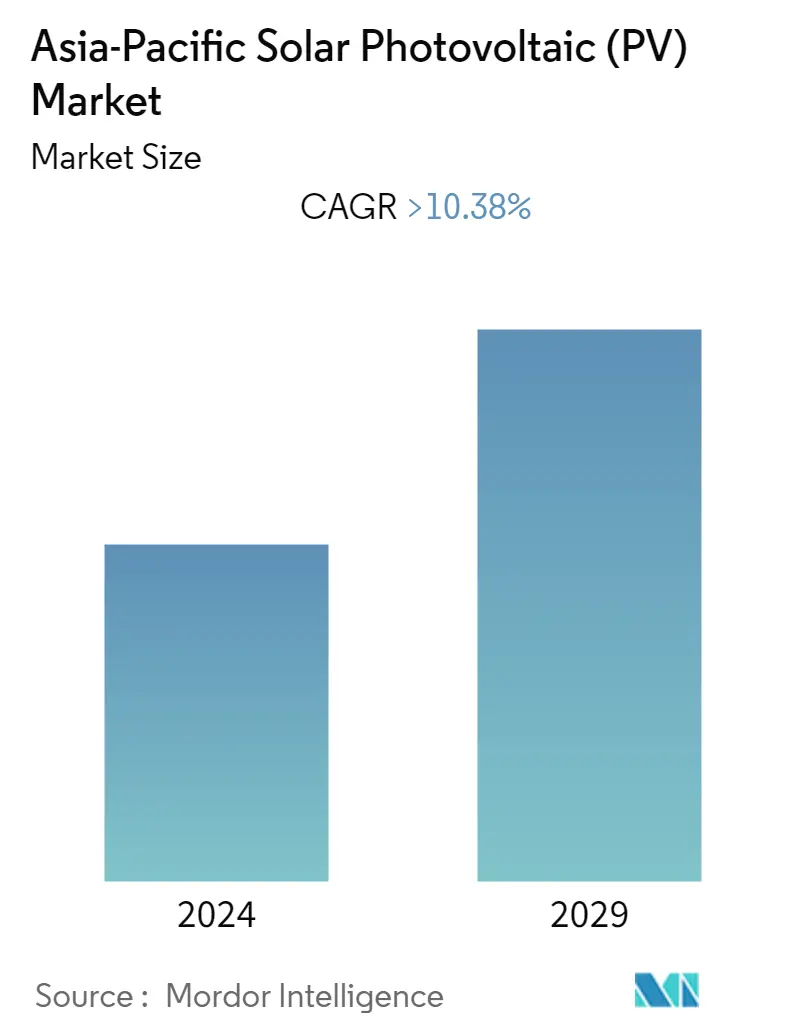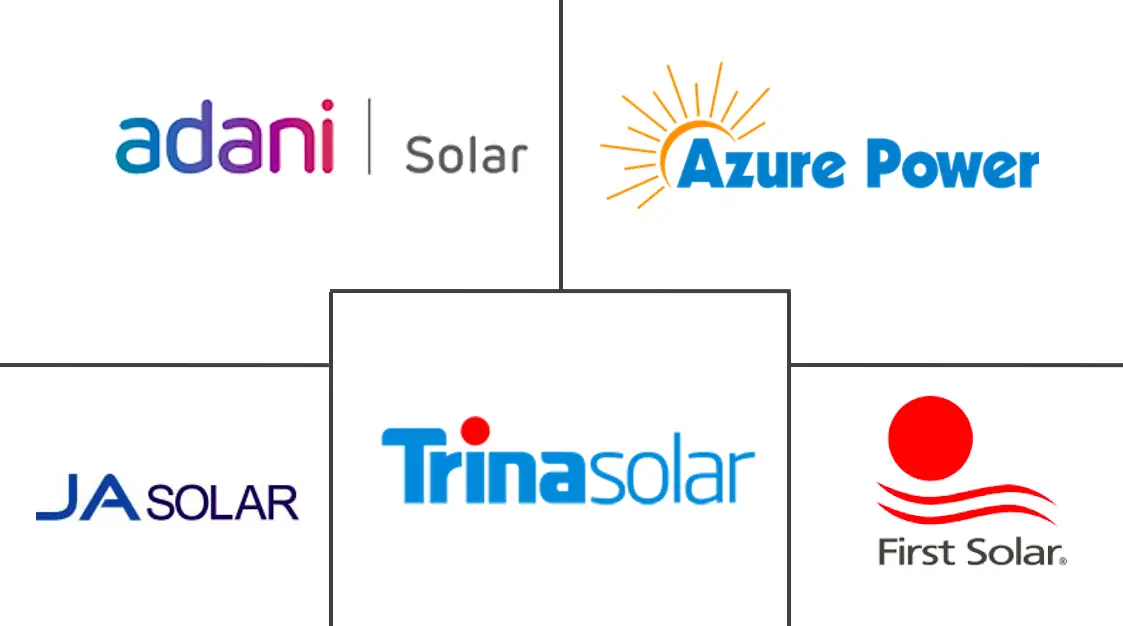Market Size of Asia-Pacific Solar Photovoltaic (PV) Industry

| Study Period | 2021 - 2029 |
| Base Year For Estimation | 2023 |
| Forecast Data Period | 2024 - 2029 |
| Historical Data Period | 2021 - 2022 |
| CAGR | > 10.38 % |
| Market Concentration | Low |
Major Players
*Disclaimer: Major Players sorted in no particular order |
Asia-Pacific Solar Photovoltaic Market Analysis
The Asia-Pacific Solar Photovoltaic (PV) Market is expected to grow at a CAGR of more than 10.38% over the forecast period.
The market was negatively impacted by COVID-19 in 2020. Presently the market has now reached pre-pandemic levels.
- Over the long term, the major factor driving the global solar PV market is the declining cost of solar PV module prices. This, in turn, is likely to have a positive impact on the growth of the solar photovoltaic (PV) market in the region.
- On the other note, the high installation cost and poor maintenance practices are restraining factors for the growth of the solar photovoltaic market. Moreover, the increasing deployment of alternative renewable energy sources is expected to hinder the market's growth.
- Nevertheless, commercial and industrial sectors are showing a growing interest in distributed solar power generation due to various economic benefits and a constant source of energy to eliminate downtimes and equipment damage due to voltage fluctuations in conventional power grids. This is expected to create a huge opportunity for distributed solar PV market in the region in the near future.
- China is expected to dominate the market over rising environmental concerns and economic benefits of domestic solar power generation.
Asia-Pacific Solar Photovoltaic Industry Segmentation
Solar photovoltaic energy or PV solar energy directly converts sunlight into electricity, using a technology based on the photovoltaic effect.
The Asia-Pacific Solar Photovoltaic (PV) Market is segmented by product type, end-user, deployment, and geography. By product type, the market is segmented by thin film, multi-crystallinee silicon, and monocrystalline silicon. By end-user, the market is segmented into residential, commercial, and utility. By deployment, the market is segmented by ground-mounted and rooftop solar. The report also covers the market size and forecasts for the Asia-Pacific Solar Photovoltaic (PV) Market across the major countries. For each segment, the market size and forecasts have been done based on installed capacity (GW).
| Product Type | |
| Thin Film | |
| Multicrystalline Silicon | |
| Monocrystalline Silicon |
| End-User | |
| Residential | |
| Commercial | |
| Utility |
| Deployment | |
| Ground Mounted | |
| Rooftop Solar |
| Geography | |
| China | |
| India | |
| Japan | |
| South Korea | |
| Rest of Asia-Pacific |
Asia-Pacific Solar Photovoltaic (PV) Market Size Summary
The Asia-Pacific Solar Photovoltaic (PV) Market is poised for significant growth, driven by the declining costs of solar PV modules, which are expected to bolster the market's expansion over the forecast period. Despite the initial setbacks due to the COVID-19 pandemic, the market has rebounded to pre-pandemic levels. However, challenges such as high installation costs and inadequate maintenance practices continue to pose constraints. The increasing interest from commercial and industrial sectors in distributed solar power generation, due to its economic benefits and reliability, presents substantial opportunities for growth. China is anticipated to lead the market, propelled by environmental concerns and the economic advantages of domestic solar power generation.
The market landscape is characterized by a dominant presence of ground-mounted solar panels, which are preferred for commercial and utility projects due to their cost-effectiveness and efficiency in large-scale installations. The Asia-Pacific region has witnessed a substantial increase in solar PV capacity, with significant investments and projects underway, particularly in India and China. The latter remains the largest market globally, with a substantial share of the world's solar power capacity. China's government initiatives and policies aimed at enhancing solar energy integration further solidify its leading position in the market. The region's market is fragmented, with key players like JA Solar Holdings Co., Trina Solar Ltd, and Adani Green Energy Ltd playing pivotal roles in its development.
Asia-Pacific Solar Photovoltaic (PV) Market Size - Table of Contents
-
1. MARKET OVERVIEW
-
1.1 Introduction
-
1.2 Solar PV Installed Capacity and Forecast in GW, till 2027
-
1.3 Recent Trends and Developments
-
1.4 Government Policies and Regulations
-
1.5 Market Dynamics
-
1.5.1 Drivers
-
1.5.2 Restraints
-
-
1.6 Supply Chain Analysis
-
1.7 Porter's Five Forces Analysis
-
1.7.1 Bargaining Power of Suppliers
-
1.7.2 Bargaining Power of Consumers
-
1.7.3 Threat of New Entrants
-
1.7.4 Threat of Substitutes Products and Services
-
1.7.5 Intensity of Competitive Rivalry
-
-
-
2. MARKET SEGMENTATION
-
2.1 Product Type
-
2.1.1 Thin Film
-
2.1.2 Multicrystalline Silicon
-
2.1.3 Monocrystalline Silicon
-
-
2.2 End-User
-
2.2.1 Residential
-
2.2.2 Commercial
-
2.2.3 Utility
-
-
2.3 Deployment
-
2.3.1 Ground Mounted
-
2.3.2 Rooftop Solar
-
-
2.4 Geography
-
2.4.1 China
-
2.4.2 India
-
2.4.3 Japan
-
2.4.4 South Korea
-
2.4.5 Rest of Asia-Pacific
-
-
Asia-Pacific Solar Photovoltaic (PV) Market Size FAQs
What is the current Asia-Pacific Solar Photovoltaic (PV) Market size?
The Asia-Pacific Solar Photovoltaic (PV) Market is projected to register a CAGR of greater than 10.38% during the forecast period (2024-2029)
Who are the key players in Asia-Pacific Solar Photovoltaic (PV) Market?
JA Solar Holdings Co, Trina Solar Ltd, Adani Green Energy Ltd, Azure Power Global Limited and First Solar Inc are the major companies operating in the Asia-Pacific Solar Photovoltaic (PV) Market.

